by Dave Senf
November 2014
Note: All data except for Minnesota’s PMI have been seasonally adjusted. See the feature article in the Minnesota Employment Review, May 2010, for more information on the Minnesota Index.
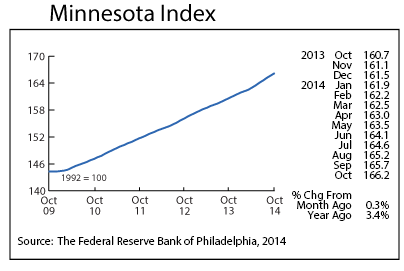
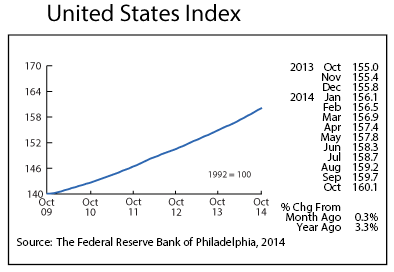
The Minnesota Index increased 0.3 percent for the sixth time in the last seven months in October, verifying that Minnesota’s economy continues to expand at a healthy pace. The U.S. index increased 0.3 percent for the ninth straight month. The Minnesota index is up 2.0 percent over the last six months, the highest six-month gain since early 2000. Job growth was strong for the third straight month, pushing unemployment down 0.2 percentage points for the third month in a row. The only negative component of the index was that average weekly manufacturing hours slipped for the second straight month. The pace of economic growth over the last six months ensures that Minnesota GDP growth for the year will easily exceed 3 percent for the first time since 2010.
Minnesota’s index in October up 3.4 percent from a year ago compared to the U.S. index’s 3.3 percent increase over the year. Minnesota’s index has been increasing faster than the U.S. index for the last four months, indicating that Minnesota’s economy has been expanding at a faster clip than the national economy. Both indices are real time monthly proxies for GDP growth which are subject to significant revisions as preliminary data, such as employment numbers, get revised when better data becomes available.
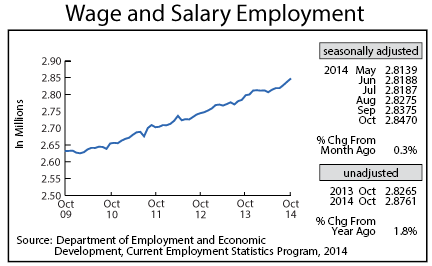
Adjusted Wage and Salary Employment climbed robustly for the third consecutive month as Minnesota’s nonagricultural wage and salary employment expanded by 0.3 percent or 9,500 jobs in October. All of the job growth was in the private sector as private employment jumped 10,200 jobs while the public sector employment dipped by 700 jobs. The last three months is the best three-month increase in private jobs since March through May 2005. Job growth was strongest in Trade, Transportation, and Utilities, Educational and Health Services, Manufacturing, and Other Services. Manufacturing employment has increased by more than 1,000 jobs for four straight months. The last time that occurred was back in 1995.
Minnesota’s unadjusted job growth over the year rose to 1.8 percent in October, trailing the national annual growth for the second straight month. Both Minnesota and the U.S. appear to be headed for a 1.8 percent annual average increase in jobs in 2014.

Minnesota’s adjusted online Help-Wanted Ads bounced upward in October, climbing 0.9 percent, slightly above the 0.2 percent national increase. October’s ad level remains high, offering a solid indicator that labor demand remains strong in Minnesota. The state’s share of online job advertising continues to come in at 2.4 percent which is well above the state’s 2.0 percent share of the nation’s wage and salary employment. Minnesota’s job growth is likely to finish out the year on a high note.
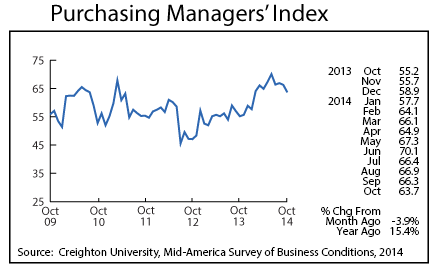
Minnesota’s Purchasing Managers’ Index (PMI) slipped for the third time in four months in October but still notched a strong 63.7. The index has only been higher 10 percent of the time since the index was first published in 1995. The solid PMI readings over the last six months have correlated with strong manufacturing job gains. Minnesota’s manufacturing sector is poised to have its best job growth since 2011 this year.
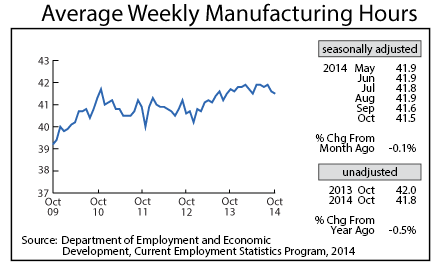

Adjusted Manufacturing Hours fell for the fourth time in the last five months but remain healthy. October’s 41.5 hours was the shortest factory workweek since April but is still higher than 88 percent of the monthly average weekly manufacturing hour estimates since 1970. Manufacturing Earnings slipped for the second straight month in October to $830.00. Factory paychecks are lower than a year earlier in real terms for only the second time in two years in October.

The Minnesota Leading Index, after dropping sharply in September, partially rebounded in October, jumping to 1.68. Minnesota’s leading index was slightly higher than the U.S. leading index and points toward solid economic expansion for the rest of the year and into the first few months of 2015.
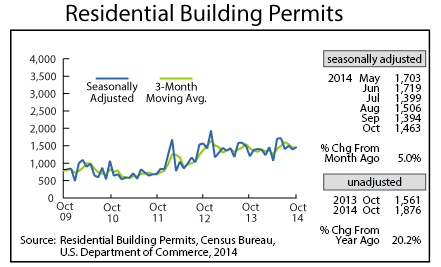
Adjusted Residential Building Permits zigzagged up in October to 1,463. Home building activity is up from last year, but the gain over 2013 has been short of expectations. Building permits were up 8 percent in 2013 but will be only 4 percent higher in 2014.
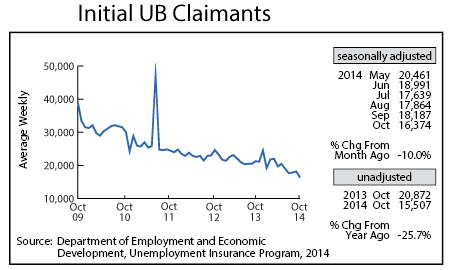
Adjusted Initial Claims for Unemployment Benefits (UB) declined to 16,374, the lowest monthly level since September 2000. The low layoff rate implies that Minnesota’s job growth should remain solid during the rest of the year.